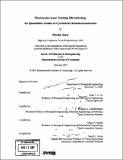| dc.contributor.advisor | Peter T.C. So. | en_US |
| dc.contributor.author | Jonas, Maxine | en_US |
| dc.contributor.other | Massachusetts Institute of Technology. Biological Engineering Division. | en_US |
| dc.date.accessioned | 2009-01-23T14:52:21Z | |
| dc.date.available | 2009-01-23T14:52:21Z | |
| dc.date.copyright | 2007 | en_US |
| dc.date.issued | 2007 | en_US |
| dc.identifier.uri | http://dspace.mit.edu/handle/1721.1/39911 | en_US |
| dc.identifier.uri | http://hdl.handle.net/1721.1/39911 | |
| dc.description | Thesis (Ph. D.)--Massachusetts Institute of Technology, Biological Engineering Division, 2007. | en_US |
| dc.description | Includes bibliographical references (p. 111-127). | en_US |
| dc.description.abstract | To shed light on the cell's response to its mechanical environment, we examined cell rheology at the single cell level and quantified it with nanometer spatial and microsecond temporal resolutions over a five-decade frequency range (- 0.5 Hz to 50 kHz). To this end, we developed and optimized an instrument for fast fluorescence laser tracking microrheology (FLTM). This novel method aims at experimentally deriving cellular viscoelastic properties from the passive monitoring of fluorescent microspheres undergoing Brownian motion inside the tested sample. Further instrument enhancement even broadens the FLTM frequency span up to seven decades by modulating data acquisition speed or complementing FLTM with a two-particle microrheology modality. In living cells, FLTM accurately characterizes the solid-like vs. liquid-like cytoskeletal behavior from measurements based on endocytosed micron-sized beads, independently of probe size or surface chemistry. FLTM also demonstrates the existence of two distinct rheological regimes on the cell surface and in the cell interior: While the former surface investigations show power-law frequency variations of the complex shear modulus G*(co), the latter intracellular experiments identify multiple time and length scales affecting cell rheological features. Finally, FLTM evaluates frequency-specific stretch-induced cell mechanics and thus promises to broaden and diversify the scientific knowledge on mechanotransduction, from a molecular and cellular standpoint. | en_US |
| dc.description.abstract | (cont.) FLTM also demonstrates the existence of two distinct rheological regimes on the cell surface and in the cell interior: While the former surface investigations show power-law frequency variations of the complex shear modulus G*(co), the latter intracellular experiments identify multiple time and length scales affecting cell rheological features. Finally, FLTM evaluates frequency-specific stretch-induced cell mechanics and thus promises to broaden and diversify the scientific knowledge on mechanotransduction, from a molecular and cellular standpoint. | en_US |
| dc.description.statementofresponsibility | by Maxine Jonas. | en_US |
| dc.format.extent | 151 p. | en_US |
| dc.language.iso | eng | en_US |
| dc.publisher | Massachusetts Institute of Technology | en_US |
| dc.rights | MIT theses are protected by copyright. They may be viewed, downloaded, or printed from this source but further reproduction or distribution in any format is prohibited without written permission. | en_US |
| dc.rights.uri | http://dspace.mit.edu/handle/1721.1/39911 | en_US |
| dc.rights.uri | http://dspace.mit.edu/handle/1721.1/7582 | en_US |
| dc.subject | Biological Engineering Division. | en_US |
| dc.title | Fluorescence laser tracking microrheology for quantitative studies of cytoskeletal mechanotransduction | en_US |
| dc.title.alternative | FLTM for quantitative studies of cytoskeletal mechanotransduction | en_US |
| dc.type | Thesis | en_US |
| dc.description.degree | Ph.D. | en_US |
| dc.contributor.department | Massachusetts Institute of Technology. Department of Biological Engineering | |
| dc.identifier.oclc | 182579716 | en_US |
